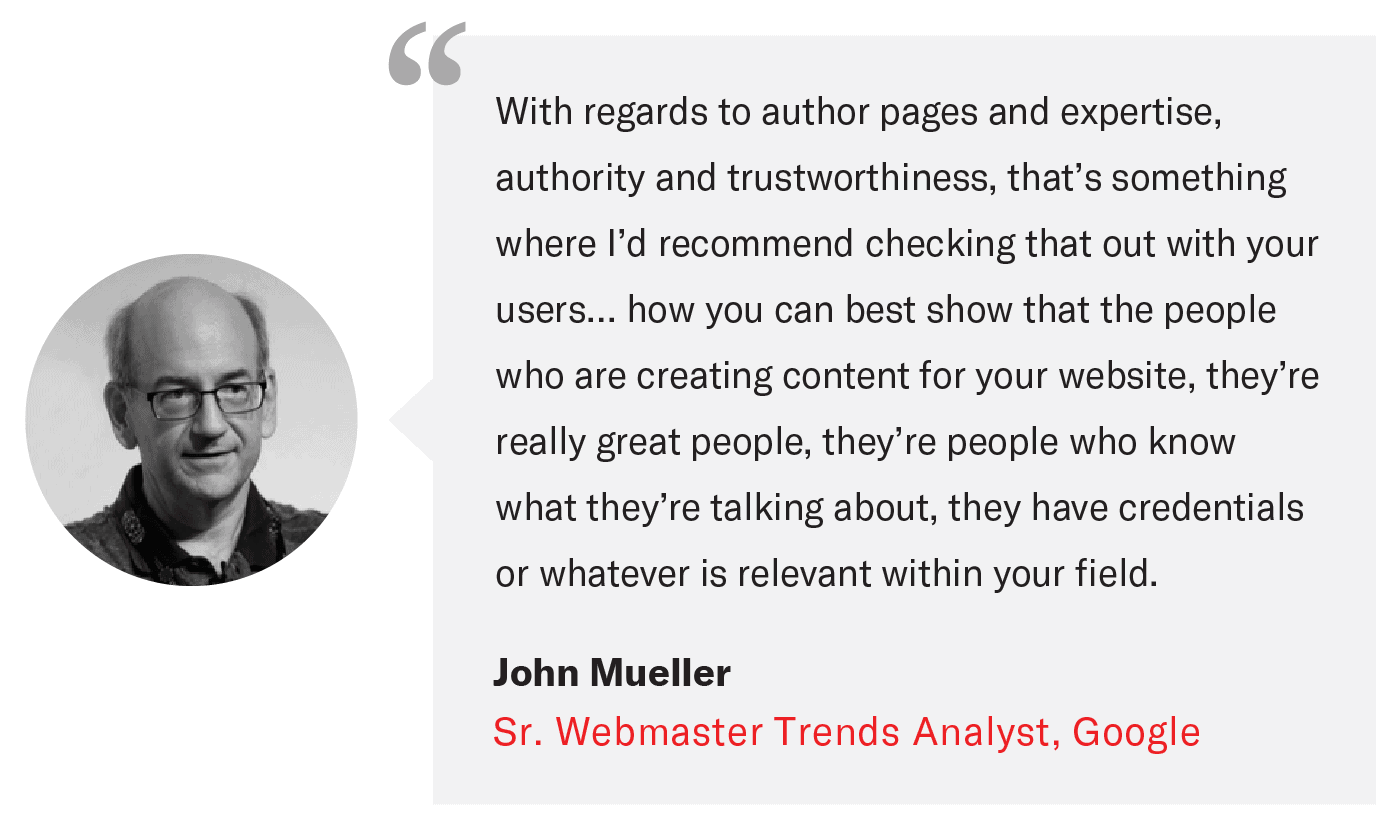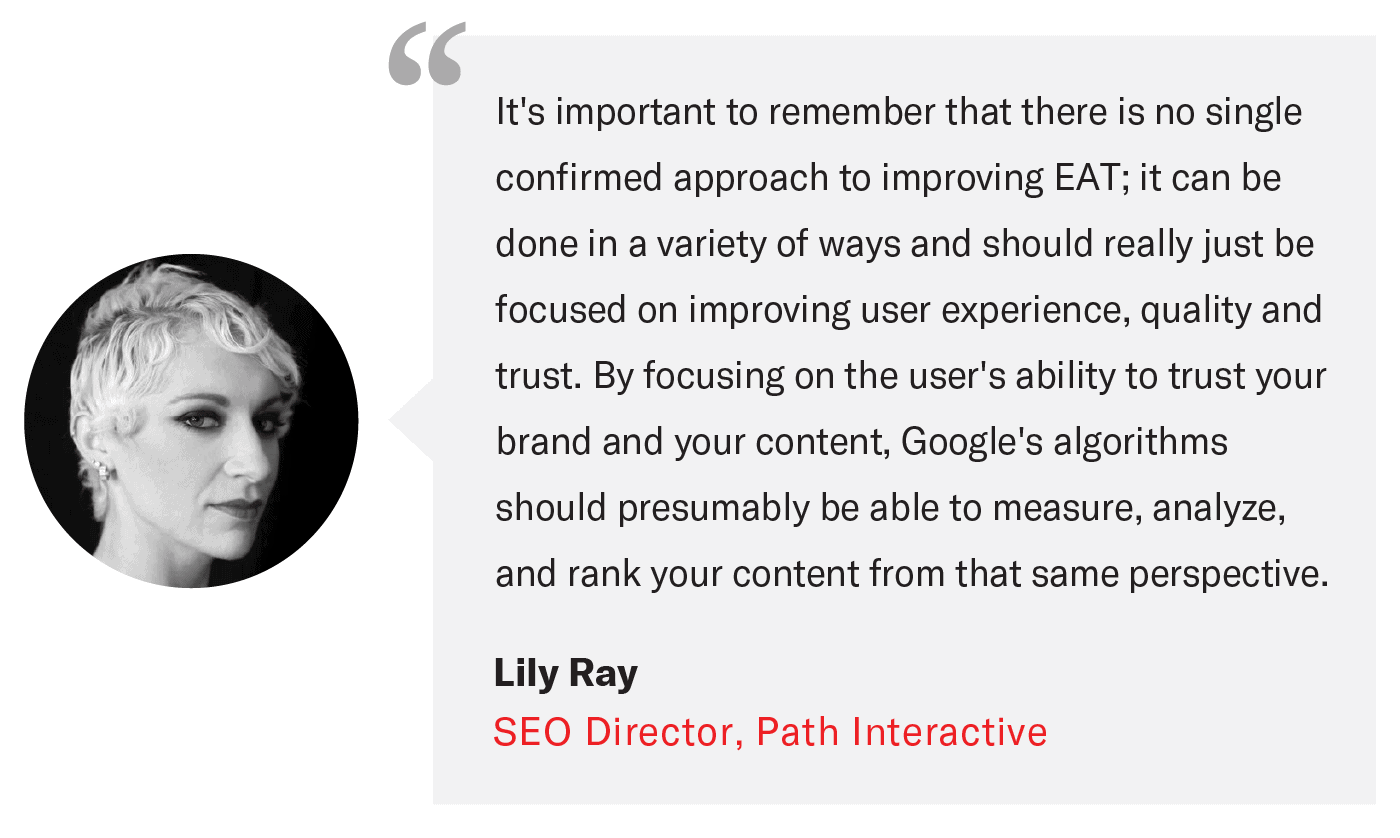After Google announced updates to their Quality Raters Guidelines, author bios were the talk of the SEO community. But do they matter?
If you run your brand’s blog, you may be wondering if incorporating an author bio or byline makes sense. SEO goals aside, author bylines can be helpful to build a relationship with your readers and grow your audience.
Our clients will come to us asking if an author bio is a good fit and our answer is: it depends.
Does an Author Bio Improve Traffic?
In short, no. If your blog content is struggling to rank, slapping an author bio on the post won’t magically get it more traffic.
In fact, John Mueller of Google has shared that author bios specifically do not impact their Quality Raters Guidelines, positively or negatively. Here is a direct quote:
In summary, you should ask yourself these questions first:
- Do I already have an established readership where associating my content with a person would help?
- Do I have credible content creators on my team I can already point to?
- Is my industry in a sensitive YMYL topic area, such as medicine or finance, where having a real person associated with posts helps?
If you answered “yes” to any or all of these questions, it may be worth creating an author bio.
3 Author Bio Options
When we’ve designed author bios for our clients, we look at three core options:
- Author name only
- Name + headshot only
- Full bio (name, headshot, biography and more)
Depending on your branding and preferences, you can go with any combination of the above. Again, since author bios don’t directly influence rankings, no need to stress over if including a staff photo will make or break your chances.
Whichever option you choose, make sure your author bio clicks through to a full page of their contributions. While we recommend noindexing these pages, it’s still nice for your readers to explore other articles that person wrote, further cementing your dedicated readership.
Which Author Bio Is Right For Me?
With all the options above to choose from, you may be unsure where exactly to start. In the end, it’s less about one format being stronger than another, rather which matches your business needs.
Option 1: General Company Byline
A common question we get is, “What happens if the author leaves the company?” Are you suddenly losing all “equity” you built with that person? Or what if senior leadership doesn’t have time to post content? Is it fair to have the content team write for the blog, but the byline goes to someone else?
One popular route is using your brand name as the byline. This is a simple solution if you want an author bio, but you don’t currently have the staff resources to assign posts to a particular person.
The “con” to this approach is that you risk a blogroll looking very redundant. And how well is that author bio serving you if it’s all the same “COMPANY NAME” listed 30 times in a row? Your users (and Google) already know it’s your brand’s content—they’re on your site!
So while this option won’t hurt anything, how much is it helping?
Option 2: Embrace Company Bios
On the flip side, if you have a content team there is no reason not to embrace authorship across the blog. This works best when you have a diverse and large (think 3+ people) team of writers. That way, if there is turnover or changes in position, your readership has established relationships with multiple people on your team.
A company that does a great job of this is Buffer, who has upwards of five or more team members contributing to the blog at any given time. What is nice about Buffer is that content creation is clearly part of their ethos—everyone from HR to marketing to the CEO is contributing.
This obviously takes time to build and Buffer has been working on their blog content since their start. If this quality is something you aspire to, author bios won’t be the only step in your process.
Option 3: Ghostwriting
As mentioned earlier, let’s say you have a small content team or you outsource a good amount of content. I don’t frown upon ghostwriting (if I did, I’d be out of a job). Having copywriters or freelance writers write for your business—and attributing that content to a more senior team member—is completely normal in this business.
We’ll have clients ask if they should have the company bio or have it be one of our team members and my answer is usually: what are you most comfortable with? We want to match whatever brand our client wants to reflect and if they want that level of transparency with their readership, then we follow their lead.
The only scenario where ghostwriting may not be a fit (and even in this case, probably still a small issue) is if you are a singular consultant or thought leader. Again, this won’t exactly get you penalized by Google and I’d argue most readers won’t care, as long as it’s still quality writing and compensation is fair.
Option 4: “Reviewed By” Byline
Another option that is popping up in the health and wellness space is a “reviewed” or “fact checked” by byline. This can either show two bylines (the original writer and the editor) or just the editor as a way of communicating to the reader that multiple people were involved in the creation of the content.
Verywell Fit is a great example of balancing two bylines at once, whereas What To Expect shows just a singular byline at the end of their content.
Option 5: No Author Bio
And the final option: just don’t do it! We’ve talked to many clients who spent time debating author bios, trying to get leadership buy in and, ultimately, deciding it wasn’t the right fit at that time. That’s a perfectly fine decision and worth returning to annually if your needs or team changes.
How to Write an Author Bio
If you’ve picked the “full bio” option, the next step will be writing your actual bio. No need to fret, this task should only take an hour of your time. At Siege, we recommend the following if it’s your first time writing a bio:
Write In the Third Person
Instead of using “I” and “me” statements, write using the third person. It may sound weird to say out loud, but will make more sense in this context.
2-3 Sentences Max
This isn’t the time to start writing your actual autobiography. Keep your bio short and sweet. The standard framework to follow is:
- 1 sentence about your current job title + job function
- 1 sentence about your experience
- 1 “fun” sentence (pets, hobbies, favorite food, etc.)
Include Social Media Handles
Encourage follows by sharing any relevant social media handles. Just make sure your accounts are actually fit for people to follow professionally.
Include a Link to Your Company
An author bio is also a great way to encourage relevant backlinks as many people will copy and paste that copy. That said, most guest posting sets these links as nofollow—although could still bring in the occasional link.
Highlight Your Expertise
Don’t be afraid to toot your own horn. In one quick sentence, summarize why you are the expert on the topic you’re writing about. Include things like years of experience, published works, degrees and/or titles, conference appearances, media coverage or past jobs.
Don’t Shy Away from Personality
Reading a quirky bio at the end of an article can make a lasting impression and encourage a future share or follow. Highlight your personality with your favorite activity or a funny joke. My colleague, Erikas Chesonis, is a perfect example over on our About page:
“About the Author” Template
If you’re still stuck on what to write, here’s a simple template to follow:
[FIRST NAME LAST NAME] is [TITLE] at [COMPANY], [JOB ROLE]. [EXPLANATION OF EXPERTISE]. [FUN SENTENCE].
And here is an example of the template in action:
Caroline Gilbert is Director of Marketing at Siege Media where she has spent 5+ years growing client accounts. She has experience ranking content for keywords ranging from 1,000 – 10,000+ in monthly search volume. You can find her on the weekends enjoying the San Diego beaches and walking her dog.
7 Creative Author Bio Examples
If you’re sold on the author bio route, nothing hurts my eyes more than a poorly formatted one. Get some inspiration from these well crafted bios below:
1. Uniformly Branded: G2
G2 has all their company headshots on a bright red background, which does double duty as a way to uniformly brand everyone at the company and draw attention to the author bio.
2. Author Name + Headshot: Buffer
Buffer does a solid job balancing a few different features in a small space. I especially like their subtle “read time” glasses icon and the subtle circle outline to their headshots.
3. Author Name Only: Makespace
While on its own the Makespace author bio is a simple first and last name, it balances nicely with the larger hero image and blog title.
4. Creative Spin: Signal v. Noise
Who said an author bio had to have a headshot? For the camera shy or fully remote team (where getting high quality, uniform images can be tough), try illustrating everyone as a creative way to add a face to the name like Signal v. Noise.
5. Full Bio: Fundera
If you opt for a full bio with lots of text and information, Fundera does a good job at including a small byline at the top and full information at the bottom so as to not busy up the top of the post.
6. “Edited By”: Verywell Fit
Verywell Fit takes their byline a step further by having the names show a pop up box on hover with each contributor’s full bio. This is especially smart in health & wellness so a reader can better understand each person’s credentials.
7. Personality: Rover
Encourage employees to have some fun with their bio copy, like including their favorite hobbies. Rover does a great job of showcasing their team’s love for their animals and their special quirks.
EAT Alternatives to an Author Bio
Instead of an author bio, there may be other content factors you should be evaluating instead that have an even greater impact on EAT. This study by Lily Ray points out the following:
- Having a clearly stated editorial policy if your business falls in YMYL categories (we really love this example from The Markup)
- Investigating poorly written or optimized CTAs on your blog
- Reviewing your external linking policy and ensuring your citations are accurate
- Include an awards, accolades, “used by” or “featured in” bar on your site
Written By: Me
Hopefully this puts the author bios debate to bed as well as provides you with some options that can fit your team and content goals. Remember: whichever option you choose make sure it’s one you’re confident you can maintain for many years. With an author bio set up, time for the hard part—actually developing your content.














